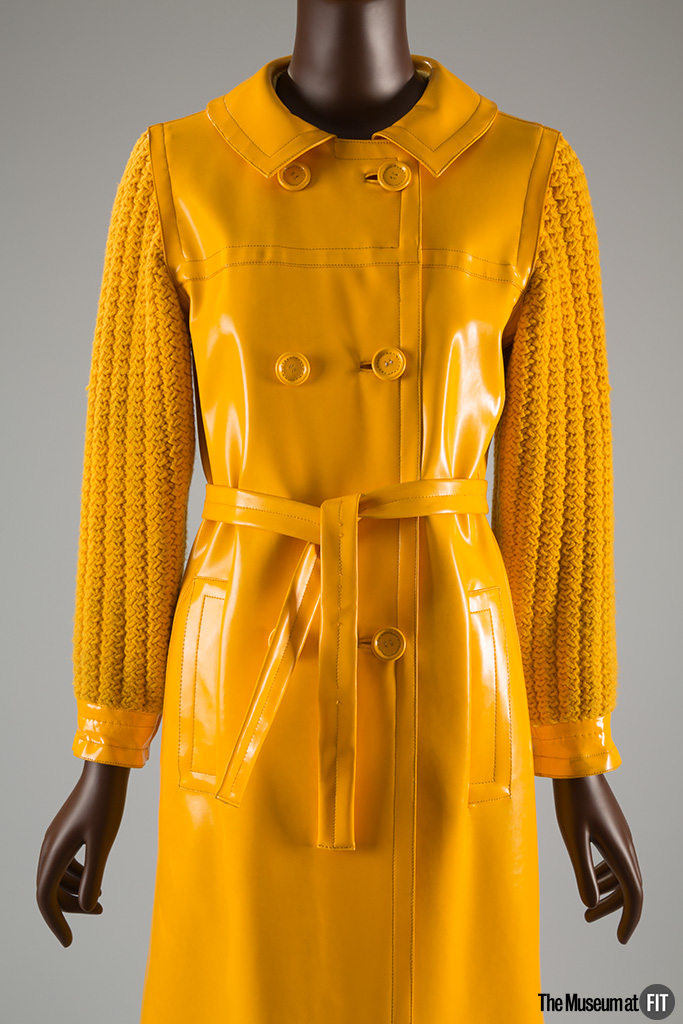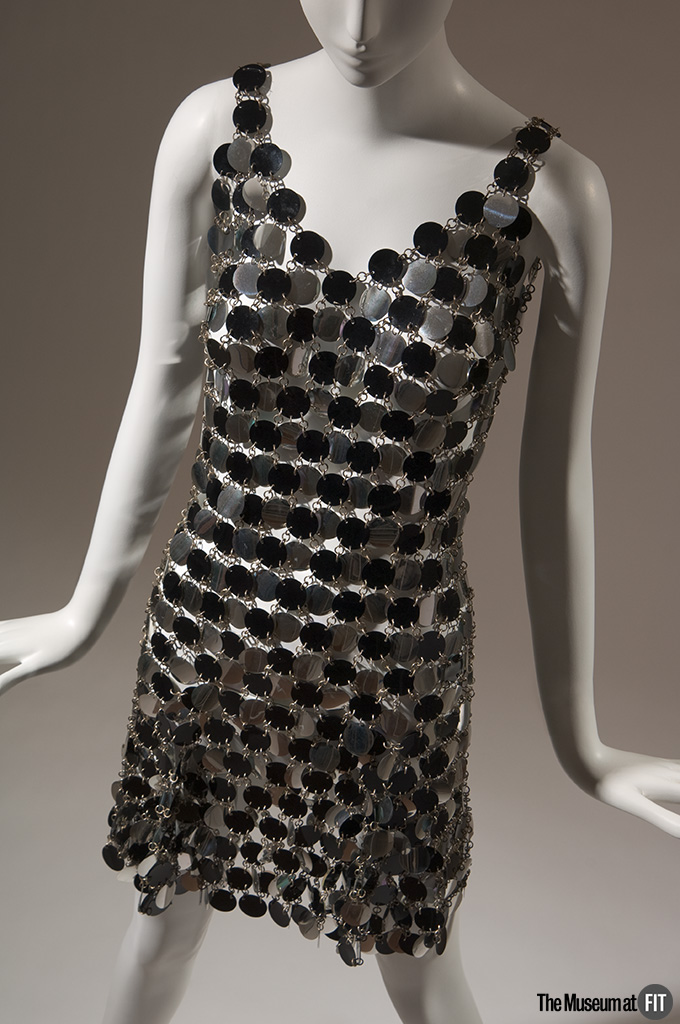Exhibition Review: Paris Refashioned, 1957-1968
The Museum at the Fashion Institute of Technology (February 10-April 15, 2017)
For those of us who find the twentieth century to be the most compelling period for the study of fashion, Paris Refashioned, 1957-1968 at the Museum at FIT is exciting in title alone. The upending events of the 1960s changed society, culture and dress with massive transitions seeming to have occurred overnight, even though the seeds had been planted ages before. Historians realize that bracketing events into decades rarely tells that story properly, as curator Colleen Hill acknowledges by starting in the year of Christian Dior’s untimely death. This show offers a refreshing break from the swinging London scene to ask how fashion with a capital F reacted to the changing nature of the times. It provides visitors with a studious visual review of the effects of French pop culture and the emerging ready-to-wear (pret-a-porter) market on the established couture houses in Paris. The related website offers a blog that spotlights key pieces in the exhibition with installation views of notable connections, like Hubert de Givenchy and his designer crush Cristóbal Balenciaga. The catalog and its numerous essays fill in the details that the short texts in the galleries necessarily omit.
I was surprised to see that the exhibition occupies the full expanse of the lower galleries— often the entry area is only partially used for framed images, small displays, and videos. Paris Refashioned takes advantage of this extra footprint to separate the residual styles of the 1950s couturiers from the colorful ready-to-wear and less staid couture in the main room. It’s easy to imagine an older, more traditional client in the former, and her younger daughter frolicking in the boutiques and sleek ateliers of the latter. One label describes how more innovative designers, like André Courreges, eclipsed the work of their more conservative peers (sorry Pierre Balmain, but look at what Oliver Rousteing has done for your name now!) Visitors who bother to read the labels, which seem to be fewer than one would hope, will see that this exhibition acknowledges them and frames their contributions within the context of the era’s fashion revolution.
As a current FIT instructor and alumni, I’ve worked on and visited numerous shows that the museum has featured. As a result, the institution’s stylistic preferences and collection are quite familiar. MFIT has a wealth of fashion history’s stars, like a “Trapeze” dress from Yves Saint Laurent’s spring 1958 couture collection for Christian Dior and one of Paco Rabanne’s plastic disc dresses, but for me it’s the lesser-known pieces that provide the most informative story. An ornate Pierre Cardin evening gown from 1957 (which Hill acknowledges is a rarity) is difficult to recognize as the designer’s work, but clearly exposes how inescapable Dior’s influence was on French fashion. Nearby, an Yves Saint Laurent for Dior cocktail dress from fall 1959 features a deep-v strap neckline that bears a serious resemblance to Rudi Gernrich’s infamous “monokini” bathing suit from 1964. It’s a good example of how the young Saint Laurent started to maneuver out from under the weight of the house’s namesake. Madame Grés, the sphinx of fashion, navigates her way into the story, too. A handful of examples reveal her malleable talent for fashion’s varied forms, ranging from a 1965 orange shift dress that looks like a Pierre Cardin copy to a spectacular brown silk evening gown from 1968 that’s more akin to a Modernist sculpture than the ancient Greek styles that inspired her best known designs.
The 100 plus objects (including a selection of outrageous hats) are grouped together or paired off in sets that speak to their similarities. The real meat of the exhibition is where couture and ready-to-wear collide, and even more so where the lower priced versions compete against each other. Emanuel Ungaro, my favorite of the avant-garde set, goes head to head with himself brilliantly. A 1968 dress from his Parallèle pret-a-porter line is adjacent to a jacket and dress from his couture collection of the same year. The combination demonstrates how a designer’s aesthetic can successfully be adapted for a lower price point by eliminating inset piecework for appliqué, but still maintain the basic form and signatures like curved pockets. A Saint Laurent Rive Gauche trench coat (circa 1967) pales in comparison to Courreges’s Couture Future version (circa 1968). Both are cotton twill, but Courreges’s distinctive heavy weight fabric and hardware elevate it to a designer garment and make Saint Laurent’s version seem more like last year’s Banana Republic.
Clips from films, music videos, and designer presentations silently loop on four monitors in the entry and a soundtrack of yé-yé music plays in the main space. The desire to show clothing in motion is apt here. The musicians and actresses make the clothing look fun and alive, whereas the models simply move around in it on the runway, even in the liveliest of stagings. “Zou Bisou Bisou” may be rattling around in my head for weeks, supplanted by the Jessica Paré version from Mad Men, which now underscores the influence of French pop culture on fashion. Case in point: Courreges’s white boots from 1964 that are similar to Francoise Hardy’s in Masculin Féminin (1966). They immediately reminded me of Bette Midler, who wondered “Why is everyone wearing white boots?” upon her arrival in New York before immediately purchasing a pair.[1] Courreges’s influence even made its way deep into the Appalachian Mountains of North Carolina, where my mother proudly wore her pearly knee-high, go-go knockoffs.
Hill concludes that the “French fashion system has been forever changed” by developments that took place during this time, namely the receding supremacy of couture in favor of ready-to-wear. Toward the end of my explorations, I got it. I knew this already of course, but what this exhibition does is to subtly offer the proof through seemingly small examples in the text and objects. A 1968 Miss Dior dress, printed with an all-over graphic logo, feels ready to be copied by fast fashion today. The label notes it as “an early example of branding that allowed consumers to ‘buy in’ to a luxury brand at relatively little cost.” It’s hard not to see this simple dress as a symbol of how far we’ve fallen into a black hole of luxury branding and faux quality. It must have seemed like such a radical concept to open the upper echelon of fashion to a wider audience, to have such an optimistic view of the world and our future.
Ending things in 1968, when Balenciaga closes his doors and massive student riots take over Paris feels like exiting just as the lights go out. It’s hard not to feel wistful for the exuberant colors, forms, and energy of that moment when going back into the grey reality of life in 2017. However, after seeing so many political statements on the runways of New York’s fashion week, I’m buoyed by the potential of clothing’s power for protest and ability to overcome its disposable reputation.
(Thumbnail image credits: Pierre Cardin, “Cosmos” dress, 1967, gift of Lauren Bacall. 72.91.30. Photograph by Eileen Costa, courtesy of the Museum at FIT.)
Notes
[1] Alexa Tsoulis-Reay, “21 Notables on the Clothes That Take Them Back in Time,” NYMag.com, May 17, 2016 http://nymag.com/thecut/2016/05/21-notables-on-clothes-that-take-them-back.html (accessed February 23, 2017).




